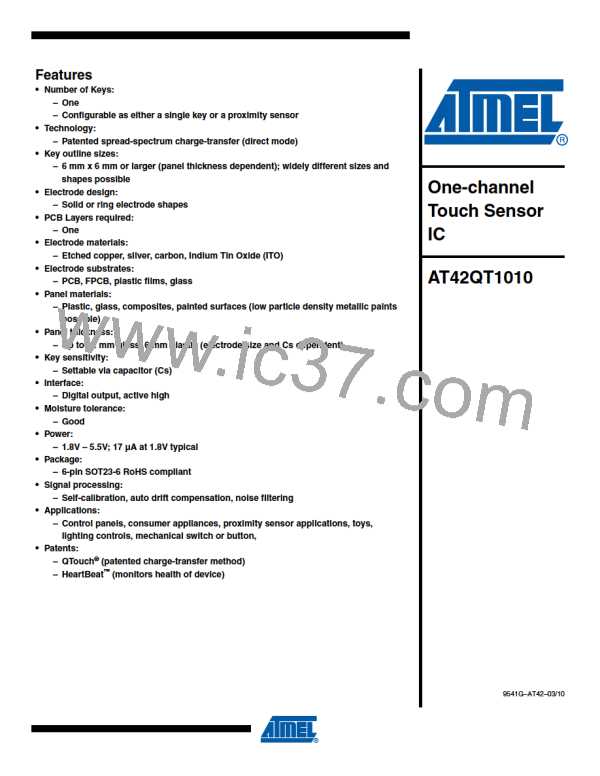AT42QT1010
3.3
Max On-duration
If an object or material obstructs the sense pad the signal may rise enough to create a detection,
preventing further operation. To prevent this, the sensor includes a timer which monitors
detections. If a detection exceeds the timer setting the sensor performs a full recalibration. This
is known as the Max On-duration feature and is set to ~60s (at 3V in LP mode). This will vary
slightly with Cs and if SYNC mode is used. As the internal timebase for Max On-duration is
determined by the burst rate, the use of SYNC can cause dramatic changes in this parameter
depending on the SYNC pulse spacing. For example, at 60Hz SYNC mode the Max On-duration
will be ~6s at 3V.
3.4
Detect Integrator
It is desirable to suppress detections generated by electrical noise or from quick brushes with an
object. To accomplish this, the QT1010 incorporates a detect integration (DI) counter that
increments with each detection until a limit is reached, after which the output is activated. If no
detection is sensed prior to the final count, the counter is reset immediately to zero. In the
QT1010, the required count is four. In LP mode the device will switch to Fast mode temporarily
in order to resolve the detection more quickly; after a touch is either confirmed or denied the
device will revert back to normal LP mode operation automatically.
The DI can also be viewed as a “consensus filter” that requires four successive detections to
create an output.
3.5
3.6
Forced Sensor Recalibration
The QT1010 has no recalibration pin; a forced recalibration is accomplished when the device is
powered up or after the recalibration timeout. However, supply drain is low so it is a simple
matter to treat the entire IC as a controllable load; driving the QT1010's Vdd pin directly from
another logic gate or a microcontroller port will serve as both power and “forced recalibration”.
The source resistance of most CMOS gates and microcontrollers is low enough to provide direct
power without problem.
Drift Compensation
Signal drift can occur because of changes in Cx and Cs over time. It is crucial that drift be
compensated for, otherwise false detections, nondetections, and sensitivity shifts will follow.
Drift compensation (Figure 3-5) is performed by making the reference level track the raw signal
at a slow rate, but only while there is no detection in effect. The rate of adjustment must be
performed slowly, otherwise legitimate detections could be ignored. The QT1010 drift
compensates using a slew-rate limited change to the reference level; the threshold and
hysteresis values are slaved to this reference.
Once an object is sensed, the drift compensation mechanism ceases since the signal is
legitimately high, and therefore should not cause the reference level to change.
7
9541G–AT42–03/10

 ATMEL [ ATMEL ]
ATMEL [ ATMEL ]